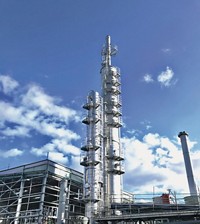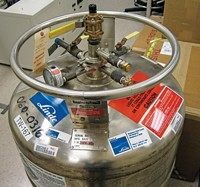Advertisement
Grab your lab coat. Let's get started
Welcome!
Welcome!
Create an account below to get 6 C&EN articles per month, receive newsletters and more - all free.
It seems this is your first time logging in online. Please enter the following information to continue.
As an ACS member you automatically get access to this site. All we need is few more details to create your reading experience.
Not you? Sign in with a different account.
Not you? Sign in with a different account.
ERROR 1
ERROR 1
ERROR 2
ERROR 2
ERROR 2
ERROR 2
ERROR 2
Password and Confirm password must match.
If you have an ACS member number, please enter it here so we can link this account to your membership. (optional)
ERROR 2
ACS values your privacy. By submitting your information, you are gaining access to C&EN and subscribing to our weekly newsletter. We use the information you provide to make your reading experience better, and we will never sell your data to third party members.
Business
Heavy Problems For Heavy Water
Exit of a major supplier has lab chemical makers scrambling
by Michael McCoy
May 28, 2012
| A version of this story appeared in
Volume 90, Issue 22

Last December, Ontario Power Generation sent a letter to a small group of customers informing them that it would stop selling deuterium oxide by the end of 2012. The company, a nuclear power producer that is the main supplier of electricity to the Canadian province, told the customers that it was keeping the material for itself.
Deuterium oxide is a doubly deuterated form of water commonly called heavy water. The planned market withdrawal is a problem because the Canadian utility is considered the world’s major source of heavy water for research facilities that use the compound and its derivatives in spectroscopy.
People such as Joseph Porwoll, vice president for global supply chain at the lab chemicals maker Sigma-Aldrich, are now seeking alternative arrangements with the handful of other heavy-water suppliers that are scattered across the globe. And one start-up company sees an opportunity to establish a new source of heavy water that isn’t tied to the nuclear power industry.
Researchers in government and industry laboratories have come to depend on heavy water, consuming tons of it and its derivatives every year. William W. Brey, a scientist at the National High Magnetic Field Laboratory at Florida State University, explains that heavy water and deuterated solvents such as acetone and acetonitrile are used in solution spectroscopy to avoid background signals from the hydrogen atoms in standard solvents.
Deuterium is also often substituted for hydrogen in proteins to improve spectral resolution or to unlabel certain sites. “A deuterium shortage would affect a broad range of chemists and biochemists the world over,” Brey says.
Canada’s pivotal role in heavy water stems from the country’s development more than 50 years ago of a unique type of nuclear reactor that depends on the compound to help achieve fission. Other countries have since followed in Canada’s footsteps by licensing its technology or coming up with their own. Today, heavy-water reactors operate in Romania, China, India, Pakistan, South Korea, and Argentina. Some of those countries also produce and sell heavy water.
All nuclear power plants create electricity through the release of energy that comes from the fission of uranium-235 atoms via neutron bombardment. Natural uranium, though, is more than 99% 238U. To attain sustainable fission, the nuclear industry in the U.S. and much of the rest of the world raises the 235U content of uranium via a costly enrichment process. The enriched uranium is then hit with neutrons that have been slowed down, or moderated, by sending them through conventional water.
In Canada, government researchers went a different route, developing Canada deuterium uranium (CANDU) reactors, which can run on the small amount of 235U found in natural uranium. The trick is using heavy water as the moderator. Because the hydrogen atoms in heavy water have an extra neutron, the molecule doesn’t absorb free neutrons as light water can, leaving plenty of them around to find and split 235U.
The ability to use natural uranium makes CANDU reactors less expensive to fuel than traditional reactors. The catch is getting the heavy water, since only about one deuterium atom exists in water for every 6,400 hydrogen atoms.
Converting or concentrating singly and doubly deuterated water to the 99.75% purity heavy water needed to effectively operate a CANDU reactor is costly. And the chemistry involved is messy. Most heavy-water plants use a multistage deuterium exchange between water and hydrogen sulfide, a toxic and corrosive gas. Another exchange technology involves the production of large amounts of ammonia.
Ontario Power generated its heavy water with the hydrogen sulfide technology. The company actually stopped producing it in 1997, according to Ted Gruetzner, manager of media relations, and has been selling from inventory ever since. The province’s long-term plan calls for two new CANDU reactors to be built, he says, and the company needs to conserve heavy-water supplies in order to fill the new reactors.
That leaves two of Ontario Power’s largest U.S. customers, Sigma-Aldrich and Cambridge Isotope Laboratories (CIL), without a key source of supply. Both companies sell heavy water and deuterated solvents to the laboratory market.
Massachusetts-based CIL claims to be the world’s largest producer of stable isotopes. Maureen Duffy, the firm’s vice president of sales and marketing, maintains that Ontario Power’s impending exit is manageable. “We’re not really concerned about ongoing supply,” she says. “From our point of view there are multiple suppliers, so we don’t envision difficulties.”
Sigma-Aldrich’s Porwoll isn’t so sanguine. He points out that interest in nuclear power is rising, whereas supplies of heavy water are not. As a result, producers and users are starting to guard their stockpiles.
By Porwoll’s estimate, the global deuterated laboratory solvents business is worth a modest $50 million to $60 million annually—small compared with the nuclear industry’s heavy-water needs. “The product line is not huge,” he says, “but it has tremendous leverage in scientific discovery because it supports an analytical technique that is ubiquitous.” Porwoll expects that Sigma-Aldrich will find the supplies it needs, but he’s concerned about the ultimate cost to its customers.
Seeing a potential problem for the scientific community, the U.S. government is aiding in the search for other suppliers. Gerald Blazey, assistant director for physical sciences in the White House Office of Science & Technology Policy, says the Department of Energy conducted an assessment of the heavy-water supply picture in response to an inquiry by CIL.
“DOE came to the conclusion that the only short-term solution is to seek heavy water from overseas,” Blazey says. The U.S. government has stockpiles of its own but, like Canada, it shut down its production facility decades ago, and it isn’t selling on the commercial market.
Alerted by Blazey’s office, the State Department recently facilitated meetings between the U.S. solvent companies and officials in Argentina, where a government-owned firm called ENSI operates a heavy-water plant. Porwoll and Duffy decline to comment on any negotiations.
Andrew T. B. Stuart, chief executive officer of Isowater, a Canadian company seeking to build a heavy-water plant with new technology, cautions against relying on supplies from any government whose primary responsibility is to supply its domestic nuclear sector. India, for example, operates several heavy-water facilities, but the country’s own nuclear power plants—plus the 22 more it has on the drawing board—are its main supply concern, Stuart says.
Isowater contends that the heavy-water business is ready for private-sector participation. “There needs to be a transition, and it needs to be very short,” Stuart says.
But building a private business on the traditional hydrogen sulfide or ammonia technology isn’t feasible, Stuart warns, both for environmental reasons and because a plant based on the processes would cost $1 billion or more to construct today.
Although he won’t provide details, Stuart says his firm’s heavy-water process can be fitted into an existing chemical plant at a much lower cost than the traditional technology. Isowater plans to have a pilot facility running in North America by the end of the year, he says, and a commercial-scale plant sometime after that.
Stuart says he’s been in the hydrogen and heavy-water fields for more than 25 years, during which time he has seen long periods of abundance due to ample stockpiles in Canada and elsewhere. Buyers need to acknowledge that those days are over, he says. “Now the market is in balance, and it is moving to shortage.”
The White House’s Blazey agrees that the situation deserves scrutiny. “There are encouraging signs that in the short term foreign supplies will be adequate. In the long term, I think it’s an open question,” he says. “What is pretty clear is that we would set back chemistry quite a ways without this material.”






Join the conversation
Contact the reporter
Submit a Letter to the Editor for publication
Engage with us on Twitter